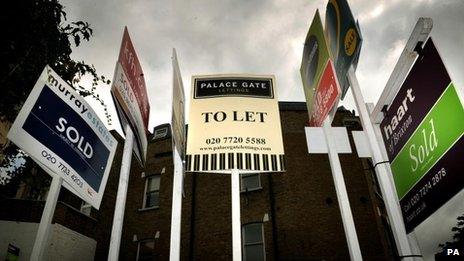Private renting in England reaches four million homes
- Published

The number of households in England renting homes from private landlords now significantly outstrips those in council and housing association homes.
The latest English Housing Survey, external, for 2012-13, says there were 4 million privately rented homes but 3.7 million homes rented from "social" landlords.
The number of owner-occupied homes continued to fall, to 14.3 million.
At 65.2% of the total, that was the lowest percentage of home ownership recorded since 1988.
The Department for Communities and Local Government (DCLG), which publishes the survey each year, said: "The proportion of all households in owner occupation increased steadily from the 1980s to 2003 when it reached a peak of 71%."
"Since then, there has been a gradual decline in owner occupation to the current 65%," it added.
It pointed out that private renting in England had been steady at about 10% of all households during the 1980s and 1990s, but had since grown sharply, nearly doubling in size.
"This was driven by a number of factors; in the late 1990s rent controls were removed, and assured shorthold tenancies became the standard, giving greater flexibility in the length of tenancies," the DCLG explained.
"Lenders also introduced the buy-to-let mortgage at around the same time," it added.
'Significant shift'
All that has gone hand-in-hand with the decline of council housing, mainly due to the introduction of the Right-to-Buy policies of the Conservative government in the early 1980s.
"The Right-to-Buy policy enabled many social tenants to purchase their home at a discounted price, and the proportion of households in the social sector declined from 31% in 1980 to 19% in 2000," the DWP said.
The housing charity Shelter said the concept of "generation rent" was a reality as more people in England were now renting their homes than buying one with a mortgage.
"The significant shift reflects the growing trend of young people and families priced out of homeownership by soaring house prices, as demand for homes outstrips supply," said the charity.
"This month, Shelter research found that average earners in England would need to more than double their annual salary to keep up with soaring house prices as they spiral further out of reach," it added.
After several years of stagnation the number of new homes being built has started to rise, prompted partly by the renewed availability of mortgage funds.
This has been brought about by government initiatives such as the Funding for Lending Scheme and the more recent Help to Buy scheme.
However, this influx of cash has also prompted a significant rise in house prices in some parts of the country, which is pushing them out of reach of would-be buyers again, just as mortgage funds have become more easily available.